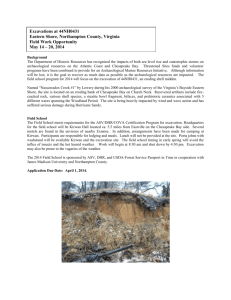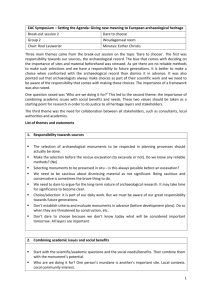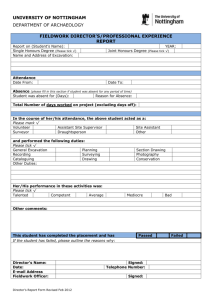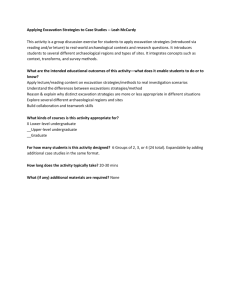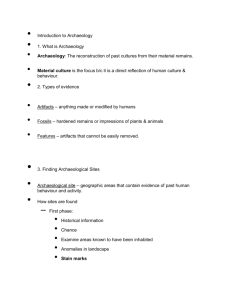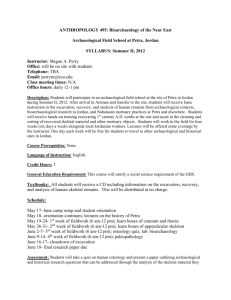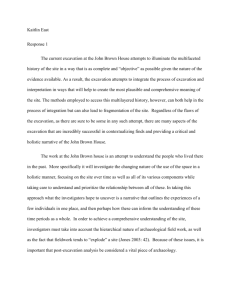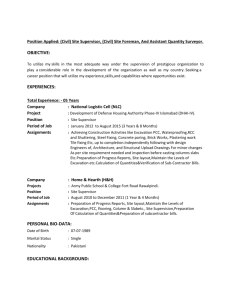Archaeology as Destruction
advertisement
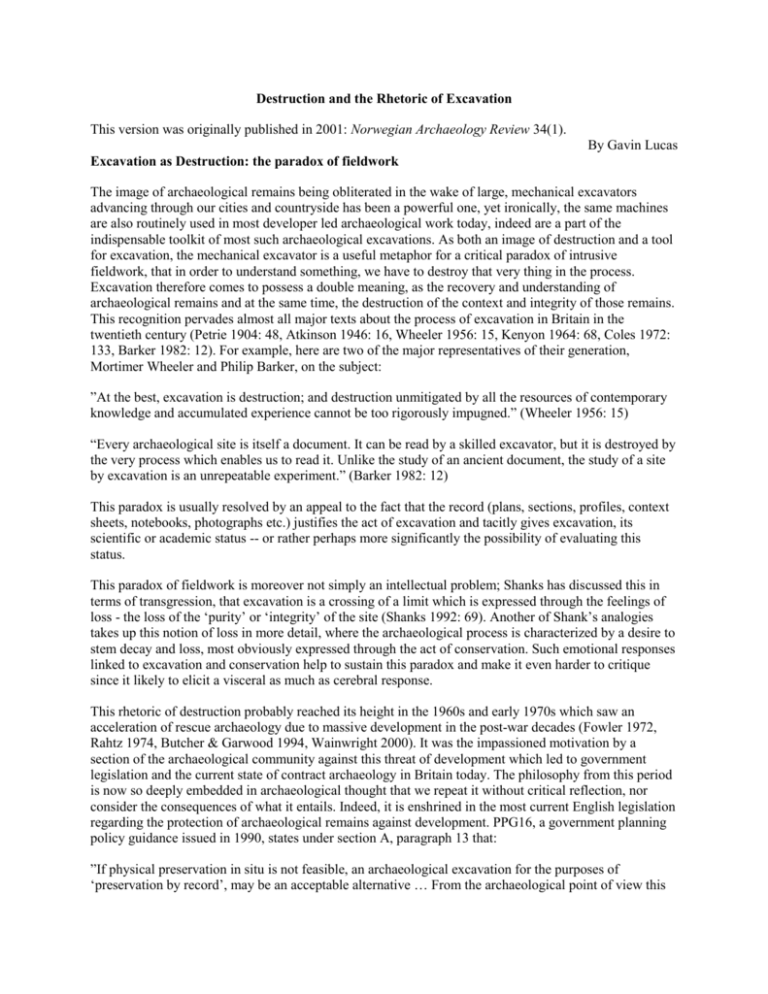
Destruction and the Rhetoric of Excavation This version was originally published in 2001: Norwegian Archaeology Review 34(1). By Gavin Lucas Excavation as Destruction: the paradox of fieldwork The image of archaeological remains being obliterated in the wake of large, mechanical excavators advancing through our cities and countryside has been a powerful one, yet ironically, the same machines are also routinely used in most developer led archaeological work today, indeed are a part of the indispensable toolkit of most such archaeological excavations. As both an image of destruction and a tool for excavation, the mechanical excavator is a useful metaphor for a critical paradox of intrusive fieldwork, that in order to understand something, we have to destroy that very thing in the process. Excavation therefore comes to possess a double meaning, as the recovery and understanding of archaeological remains and at the same time, the destruction of the context and integrity of those remains. This recognition pervades almost all major texts about the process of excavation in Britain in the twentieth century (Petrie 1904: 48, Atkinson 1946: 16, Wheeler 1956: 15, Kenyon 1964: 68, Coles 1972: 133, Barker 1982: 12). For example, here are two of the major representatives of their generation, Mortimer Wheeler and Philip Barker, on the subject: ”At the best, excavation is destruction; and destruction unmitigated by all the resources of contemporary knowledge and accumulated experience cannot be too rigorously impugned.” (Wheeler 1956: 15) “Every archaeological site is itself a document. It can be read by a skilled excavator, but it is destroyed by the very process which enables us to read it. Unlike the study of an ancient document, the study of a site by excavation is an unrepeatable experiment.” (Barker 1982: 12) This paradox is usually resolved by an appeal to the fact that the record (plans, sections, profiles, context sheets, notebooks, photographs etc.) justifies the act of excavation and tacitly gives excavation, its scientific or academic status -- or rather perhaps more significantly the possibility of evaluating this status. This paradox of fieldwork is moreover not simply an intellectual problem; Shanks has discussed this in terms of transgression, that excavation is a crossing of a limit which is expressed through the feelings of loss - the loss of the ‘purity’ or ‘integrity’ of the site (Shanks 1992: 69). Another of Shank’s analogies takes up this notion of loss in more detail, where the archaeological process is characterized by a desire to stem decay and loss, most obviously expressed through the act of conservation. Such emotional responses linked to excavation and conservation help to sustain this paradox and make it even harder to critique since it likely to elicit a visceral as much as cerebral response. This rhetoric of destruction probably reached its height in the 1960s and early 1970s which saw an acceleration of rescue archaeology due to massive development in the post-war decades (Fowler 1972, Rahtz 1974, Butcher & Garwood 1994, Wainwright 2000). It was the impassioned motivation by a section of the archaeological community against this threat of development which led to government legislation and the current state of contract archaeology in Britain today. The philosophy from this period is now so deeply embedded in archaeological thought that we repeat it without critical reflection, nor consider the consequences of what it entails. Indeed, it is enshrined in the most current English legislation regarding the protection of archaeological remains against development. PPG16, a government planning policy guidance issued in 1990, states under section A, paragraph 13 that: ”If physical preservation in situ is not feasible, an archaeological excavation for the purposes of ‘preservation by record’, may be an acceptable alternative … From the archaeological point of view this should be regarded as a second best option. The science of archaeology is developing rapidly. Excavation means total destruction of evidence (apart from removable artifacts) from which future techniques could almost certainly extract more information than is currently possible. … The preservation in situ of important archaeological remains is therefore nearly always to be preferred.” (HBMC 1991a) Now I would not wish to lessen the significance of the discussion of destruction in the heyday of rescue archaeology - it certainly had an impact and a positive one at that; however, it is questionable whether we should still be using this rhetoric, in fact ask whether it may not be detrimental. For example, while the preference of preservation in situ over preservation by record is promoted in an environment where archaeological remains are under threat from development not from research, it is ironic that developerled archaeology has shown that there is far more archaeology out there than previously assumed. Preservation, initiated as a response to what was seen as a dwindling resource, no longer has this justification to back it up. Moreover, one could argue that the reason for preservation, namely improved methods and techniques in the future, is also flawed. Martin Biddle, in a keynote address to the Institute of Field Archaeologists in 1994, argued that if preservation is taken to its logical extreme, then there will be no more excavation and ultimately no more knowledge; as he says, ‘we cannot conserve what we do not understand’ (Biddle 1994: 17). Biddle asks: how will future archaeologists excavate a site better than us if they have no experience, no sites to practice on? Moreover, if future generations uphold this view, then excavation could potentially always be deferred to a never arriving present, and a site will be preserved in perpetuity for no one, turning preservation into an oxymoron. This is of course an overstatement and no one seriously argues that everything should be preserved, but by having preservation as the first option, it promotes a philosophy where the sheer existence of archaeological remains is more important than their significance or importance. While the debate about preservation may, in practice, be much more about where to draw the line rather than an absolute preference for total preservation, whatever position one adopts along this axis, there is usually always a shared perception that excavation is still destruction, the difference lying merely in when and where it is not justified. Typical of the language of cultural resource management is the idea that archaeological remains are a resource, as if it were akin to minerals or some other natural commodity. The metaphor is continued through associated terms such as ‘finite’, ‘non-renewable’ and ‘sustainable’. Indeed, by characterizing the archaeological record as a resource, as something which is either destroyed or preserved, independent of any intellectual evaluation we place over this resource, we encourage a view of the past as separate from the present and future, more significantly as something which has been arrested, as something static, dead. In viewing the archaeological record as a resource, it is as if it were a commodity or raw material involved in a process of production - in this case, the production of knowledge. Indeed, it is no coincidence perhaps, that just as we view it as a resource, in contract archaeology the developer views it as a contaminant, something that needs to be removed before building can proceed. Archaeology as resource/contaminant are two sides of the same coin. This state of affairs, while it may be expedient in the short run, can only be detrimental in the long term as it is divisive, ultimately sustaining a tension between the interests of the archaeologist and the developer. Problems with the Received View of Fieldwork I do not which to argue that all those things which make up a site – soil, pottery, bones etc. – do not exist prior or independent of our engagement of them, but it is at the same time meaningless to argue so, since their existence as archaeological remains is entirely dependent on our characterization of them as such. This does not simply apply to the way in which we distinguish features from each other but more importantly, through acts of identification involving deeply ingrained normative categories such as ‘pit’, ‘ditch’ or ‘posthole’, or even the way we separate entities of apparently different orders such as finds from deposits. A whole classification of knowledge or ontology is at play which exists at a subconscious level in fieldwork and which guides the way in which we ‘work a site’ in the process of excavation. This covers not just excavation but all forms of archaeological fieldwork, from earthwork survey to geophysical survey. In either case, whether it is the greyscale plot of a resistivity survey or the measured plan of earthworks, we constitute the archaeological remains through our engagement with them and the tools we use in that engagement. One way to attempt to ensure proper fieldwork is to structure it according to theoretically informed questions and problems. However, this can in turn, all too easily become articulated through a division between an ‘objective’ recovery of data and its more ‘subjective’ interpretation or analysis, a dichotomy which seems to underlie Carver’s distinction between the definition and determination of data and his characterization of fieldwork as a shopping trip for data, theory merely affecting what is put on the list (Carver 1989: 669-70). But this just defers the problem of the object/subject split, it does not change it. Indeed, there is now a growing literature on the conceptual nature of archaeological fieldwork in the light of post-processual critiques of positivist epistemology, in short that all archaeological work is theoretically-laden or interpretive, not just higher-level analysis and synthesis. For example John Barrett, Ian Hodder, Colin Richards and Chris Tilley have all, in recent years, questioned the supposed passivity of fieldwork and the received view that it is primarily an objective. This critique highlights a second problem I want to raise; that the received view valorizes the act of fieldwork in such a way that the record is more important than the act of excavation, which is marginalized. As Tilley has expressed it, the final product is more important than the process (Tilley 1989). At the coarsest level, excavation in itself is devalued as a negative, destructive act in contrast to recording, which is positive. Now while this would seem to ignore the fact that excavation is still recognized as a skilled endeavor, nevertheless by focusing on the issue of skill, it moves the discussion into the subjective realm and one, which by association is marginalized in discourse. Thus while we often claim that an unskilled excavator may destroy archaeological remains, there is no discussion of what ‘skill’ is in field manuals - indeed it is usually something which we argue cannot be gained from books but comes only through practice. It lies outside ‘proper’ or academic discourse on fieldwork. So, while it is too simplistic to claim that the act of excavation has negative connotations while recording is positive, those positive elements of excavation are still marginalized theoretically by aligning them to the subjectobject dichotomy discussed in the first problem. The same process recurs in a third problem, which can be seen at work in the concept of discovery. The public perception of archaeology and fieldwork in particular, is closely entwined with the idea of discovery. That what archaeologists do is discover things, whether it is buried treasure or ancient cities. This is the thrill of archaeology, why ‘everyone wishes they could do it’. This perception is reflected in the more popular books and television programs about archaeology and even most academic histories of archaeology (at least until recently) could not have been written without heavy reference to great archaeologists and their great discoveries. It is also expressed in the more intellectual idea of excavation as detection, the archaeologist as detective. Nevertheless, in any textbook on field methods or even more theoretical works on archaeology, discussion of the role of discovery is glaring by its absence. Pick up Barker’s Techniques of Archaeological Excavation (1977, 1982, 1993) for years now the standard reference on fieldwork in the UK, and the word does not even figure in the index, let alone as a topic of discussion. Towards an alternative view of fieldwork The problems addressed above all tend to be caught up in potentially vicious dichotomy that we have to destroy that which we wish to understand. In order to move beyond these problems, it would be useful to first question what we mean when we state that excavation is destruction, and ask, is it in fact, the right term to use. In excavating a site or a feature, we do not annihilate matter, it does not vaporize or disappear - it is merely displaced. This displacement of course alters its configuration and it is this we are chiefly concerned with - what we generally call ‘context’. But if this is the case, it is hard to argue that the ‘context’ is any more destroyed than it is created in the act of excavation, accepting the arguments presented above about the nature of fieldwork. The context is created through the very act of intervention at the same time as it is destroyed. But if we want to avoid returning to a dichotomy here, we should perhaps instead focus on the notion of displacement or transformation which mediates this process of ‘contextualization’. To paraphrase Barker quoted at the start of this paper, the very process which enables us to read a site also changes it. Excavation is not so much destruction as displacement, and Barker’s phrase has much more resonance with the notion of the double hermeneutic when read in this light (Giddens 1984: 284, 374). Just as in any social science which involves fieldwork, the presence of the fieldworker can affect the subject of their study, the same is true of archaeology. In other words, it is more fruitful to see the paradox of fieldwork as a hermeneutic - rather than destroying that which we wish to understand, we alter it. Lest one thinks this modification to the issue somehow detracts from the irrevocability of excavation, it is important to distinguish this aspect of irrevocability from destruction; they are not synonymous and irrevocability equally applies to the notion of displacement. Thus excavation might still be characterized as an unrepeatable experiment, one to which we can never go back, for each time we excavate a site, it will never be the same after our intervention. But the same applies to any social science and its fieldwork, as expressed in the double hermeneutic. Indeed, we often forget that the very option of going back or asking other questions would not arise without the initial intervention in the first place. Rather than bemoan the irrevocability necessarily entailed in excavation, it might be more productive to consider specifically what the act forecloses. Excavation can be anything from partial to total, but even then, in many cases the holes and signs of the excavation remain, the removed layers, although displaced, may still lie on site. We can often return to a site and still conduct more work. I say this not to deny that excavation changes a site but to affirm it - to affirm the fact that it changes it rather than destroys it. In contrast, if we use the term destruction, it carries with it such finality and totality that there is no room for such subtle qualification - rather we are presented with a stark polarization, between preserving something and nothing. We have to ask how and to what extent fieldwork will transform the site and equally importantly, whose interests is it serving - or not serving? Thus it may matter to other archaeologists that the wrong questions, and therefore the wrong displacement is being made through excavation; it may matter to people outside the archaeological community indigenous groups for example, that any attempt to intervene in a site in this way is wrong. I would not contest this, but it need not be argued through the rhetoric of destruction because this tends to polarize the argument. Certainly we can never go back; acts of excavation are unique, but equally they transform or displace material in a unique way. It is this uniqueness which should make us aware of the complexities of excavation and its effects on the site rather than reduce this complexity through the totalizing notion of destruction. Viewing excavation as a unique displacement emphasizes that any intervention needs to be negotiated in its own terms and according to relevant interest groups. Viewing excavation as displacement helps in re-thinking the problems discussed above under the received view of fieldwork. So in terms of cultural resource management for example, I would argue that preservation is the wrong concept to be using - it has too much of an association and opposition to destruction. The issue is always first and foremost about the transformation of a site - about how we want the site to appear after our intervention. The question applies equally to research or fieldwork on protected sites as with excavation under development conditions. Indeed, such a perspective enables the activities of archaeology and development to work together in a more productive manner, for both are in fact creating a site, a place. If archaeology creates a past, and development is creating a future, both are still working in the present and together they could constitute the historical process in potentially one of the most reflexive ways possible. The real challenge comes of course, not when there are standing remains such as earthworks or architecture and where there is clearly a common materiality over which both the archaeologist and developer can co-operate, but on sites where there was nothing visible above ground before archaeological intervention. These kind of sites are much more common. Should it be the case that once the archaeologist leaves such a site, its archaeological significance, as a place (not just the location of an excavation) disappears? More theoretically, accepting this notion of excavation as displacement, helps to break down the dichotomy between the archaeological act and the archaeological remains. Instead of seeing the fieldwork process in terms of epistemological and methodological problems about the relation between an object and a subject, it becomes a practice which entwines both the constitution of the archaeologist and the archaeology. One direction in achieving this might be through an ethnology or anthropology of fieldwork practice; as archaeologists, we have learnt to do things in certain ways and we repeat them over and over again on every site, from general practice of planning features or drawing sections, to the more specific ways in which we may excavate a feature such as half-sectioning a ‘pit’ or a ‘posthole’ or putting a meter slot through a ditch. For example, in discussing how excavators recognize objects or features as they dig, Edgeworth cites the concept of practical analogy or analogy-in-action, whereby the excavator draws on a frame of reference, very much inscribed in the body, which implicitly guides the experienced excavator and which new archaeologists learn over time (Edgeworth 1990). This is one way for example of integrating a discussion of ‘skill’ into mainstream discourse about fieldwork where it had previously been marginalized. A further consideration is the way in which such ‘analogies-in-action’ are differently ‘performed’ by different excavators because excavation, like any practice, is always inter-linked by other ‘performativities’, to adopt a concept by Judith Butler (Butler 1993). For example, one primary intersection is gender and Joan Gero in particular has explored how masculine and feminine performances of fieldwork vary, in particular how masculine practices tend to draw attention to themselves as important (for example through the size of pedestals of soil left to support stones) or prefer certainty to ambiguity (for example through use of solid lines on plans rather than shading; Gero 1996). Materializing the site: excavation and archiving All excavation is therefore a material intervention which changes the way a site looks, indeed the manner in which it is carried out it structures our ability and the way we ‘see’ the site. At a basic level we can link this observation to the need for site ‘tidiness’. The presence of straight sections and baulks, grids and strings, the spoil moved out of site , etc. act to encourage a perception of tidiness and order or control, while a site which lacks these elements is often taken to denote chaos and consequently failure of understanding. A classic example of this is Wheeler’s comparison of a chaotic and disciplined excavation in his field manual, Archaeology from the Earth (Wheeler 1956, see Plates 4a and 4b, also p.80). Yet such approaches to the material presentation of the site are only linked to ways of seeing and do not, in themselves necessarily denote such a failure. More specifically, different fieldwork practices in different parts of the world or from different periods, produce different sites and therefore different understandings (see Lucas 2001, esp. ch.2). For example, there can be a stark difference between much of the fieldwork conducted in Britain and the United States. In the former, the use of single context excavation and planning produces an open area site with the soil sculpted in shapes conforming to perceived features (contexts). In the States by contrast, the unit level method produces a site where the shapes of such features may be superimposed by a regular grid of squares (units). Having worked on a site where both methods were used in two separate areas side by side, it is worth remarking how each team wondered how the other managed to keep track and work out what was going on in their respective areas. Each party found it hard to see how the other could work on a site which took such a material form. Does the archive justify, not so much destruction (as in the received view) but irrevocability? The question of the archive is a critical one, for it is the only medium through which a site in all its detail is perceived by the archaeological community at large - for any one site, only a small percentage of archaeologists are present during its excavation compared to the numbers who may refer to it in their research. What, then, is the archive? One of the most immediate responses would probably be that it is a representation of the site through images and text, with an attendant responsibility for accuracy. Yet this representational understanding of the archive does present a problem. The archive as representation carries with it a platonic metaphysics of the original and the copy, the original being the site, the archive the copy. Now this is precisely what the received view of fieldwork feeds off, with the idea that in making the copy we destroy the original. The archive would seem therefore, from the start, to carry with it both a sense of loss, loss for the original and guilt, for its very existence derives from the destruction of the original (cf. Derrida 1996). Because of this view of the archive, it carries this burden and will always be open to critique for not fully living up to its original - the archive will always be deficient with respect to the site. I do not think this is a very healthy position to be in. Instead of focusing on a ‘dependent’ or derivative view of the archive as copy, I want to consider its independence, the fact that an archive, instead of representing the site, displaces it. The archive comes to stand in for the site, not as a copy to an original, but as simply a substitute - it is a metaphorical rather than representational relation. Moreover it does this, I would argue, precisely because, unlike the act of excavation, it sustains the possibility of repetition; we can, in principle, always go back to the archive. The objects selected to be removed and stored from site and the textual and graphic productions made, create the possibility of iterability. By this I mean that they are materializing strategies for enabling the archaeological record to be subject to repeated investigation. Moreover, seen in this perspective, artifacts or more generally any finds ‘brought back’ from the field are no more authentic or closer to the past than our plans or photographs - they are just as ‘constructed’, materialized. In the first place, through their very selection and removal from context, they become different things; but second, our ascription of a find as a kind of thing, from a specific type of pottery to a generic piece of worked bone, has already rematerialized it as some thing. The subsequent way in which we go on to analyze and interpret a site is already pre-formed by the materializing strategies we use in the field, from the way we draw a section to the way we select, bag and label our finds (Lucas 2001). The archive we create in archaeology is our answer to the scientific experiment -- it is a way of reexcavating a site, re-analyzing an object over and over again. Without these materializing practices, there would be no archaeology -- they allow its discourse to develop. In this way, the idea of material culture as something central to archaeology refers not simply to its subject matter but to its very constitution. It is this materiality which actually enables archaeology to function as an iterable process. However, there is of course a danger of the archive becoming too self-referential, by which I mean, in striving for independence through internal consistency and closure, its iterability becomes the repetition of sameness. For example, the desire for increased standardization and cross-referencing in recording on site may result in a homogenizing process of archiving, where one pit, one structure, one site begins to look like another. Indeed, it can often feel like this on site where the very structure of the archiving process creates this sameness. One ditch will almost inevitably come to look like another if we record it in the same way, going through the same motions of filling out a pro forma sheet, drawing the section and taking a photograph, all following the prescribed conventions. Of course there are differences but the desire for a totalizing archive (cf. Carver 1989: 670), that is, an archive which strives too much to be compatible with others, will lose its uniqueness and foster an homogeneous past. The problem is how to sustain iterability as a heterogeneous concept rather than an homogeneous one, repetition as difference rather than the return of the same (cf. Deleuze 1997). How to keep the archive from becoming a closed entity. This very indistinction makes the question of openness more urgent - how to avoid an archive (or excavation for that matter) becoming self-fulfilling? It is a pit because we dig it/record it like a pit. One way is to consider what one might call the ‘marginalia’ of fieldwork - the things which do not normally fit into the system of the archive or the excavation. Conversations about a feature, over-cutting a feature, notes on the margins of record sheets, even splattered mud on plans and section drawings. These lie outside or on the margins of the archive proper, and as such disrupt the self-referencing propensity and inclination for closure of the archive. Indeed we sometimes go to great lengths to erase any traces of these things - by wiping off the mud, redrawing a plan. But such things remind us that the archive is a process, not a thing, that what we record is an open process. And this is not a bad thing, in fact this kind of ‘antiarchive’ is something we should consider more seriously in order to guard the heterogeneity and uniqueness of sites against the homogenizing tendency of the archive. More positively, we need to sustain a correct balance between generalization and the specificity in our excavation/archiving of a site and this, above all, I believe, means continually re-evaluating the relation between our excavation and archiving practices so that they do justice to this fact.
